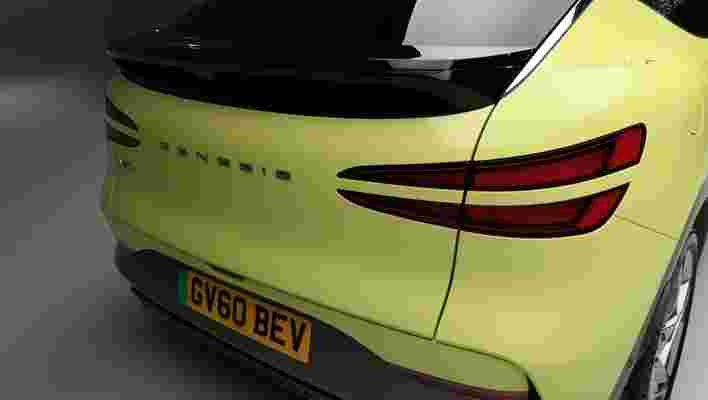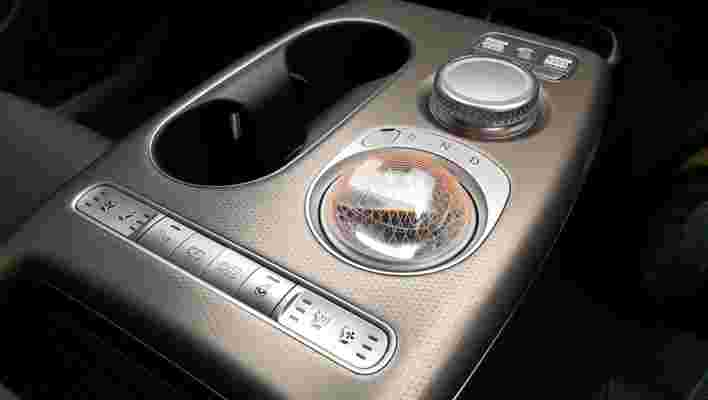Genesis is the luxury arm of Hyundai and its profile is building nicely in Europe while already being a reasonably well-known brand in the US since its launch back in 2016.
However, up until now it has been without a dedicated EV to shout about, but all that is set to change with this, the brightly coloured Genesis GV60.
TechRadar recently had the chance to see the firm's first electric car up-close, in the decidedly flamboyant Sao Paulo Lime finish you see here, and it's a real looker.
The first thing that strikes you about the Genesis GV60 is it seems larger than expected, a bit like the Hyundai Ioniq 5 in fact. Not too surprising given the GV60 is built on Hyundai's dedicated e-GMP platform, just like the Ioniq and Kia EV6 .
It's got the Genesis identity too, with some tell-tale signs that show its part of the range, which includes the GV70, GV80, G70, G80 and G90. Interestingly, the GV60 sits alongside the GV70 and GV80 SUV models on the Genesis website, although from a distance it looks like more of a sedan.
That's probably because the Genesis GV60 is quite deceptive. While it looks bigger in the metal from the outside, especially with its 21-inch alloys, it's not until you peek inside that the EV reveals itself as a surprisingly spacious premium motor.
And, as you'd expect from the South Korean manufacturer, it also comes packed to the hilt with clever and innovative features.
A trio of choices
Our first viewing of the Genesis GV60 took place in a studio in the commuter belt of London, so the EV had a European specification. The Genesis GV60 will be available there with a choice of three different motors, including a 168kW rear-wheel-drive single motor option boasting 350Nm of torque, aimed at users who want long-range capabilities.
There are also two dual motor all-wheel-drive models, the Standard AWD and Performance AWD. The former offers 234kW of combined power, 74kW from the front motor and 160kW from the rear to produce 605Nm of torque.
The latter Performance edition delivers 360kW with 180kW front and rear and a maximum available torque of 700Nm.
The Genesis GV60 sports four doors, has a lifting tailgate/hatchback and can seat five passengers, two in the front and three in the back. The overall dimensions are 451.5 cm (length), 189 cm (width) and 158 cm (height) with a wheelbase of 290 cm and a ground clearance of 160 cm.
The trunk features 432 litres of capacity while at the front there's some additional storage in the shape of 53 litres for the rear-wheel-drive model and 20 litres for the all-wheel-drive edition due to the extra componentry that's packed in.

Exterior 'Elegance'
Before we get to the interior, let's take a closer look at the exterior, which is based on the Genesis 'Athletic Elegance' design ethos.
Having seen the Sao Paulo Lime shade in promo shots the color looks even better in real life. It really helps to compliment the curves of the GV60, which is instantly recognizable as a Genesis mainly because of the front end.
This is especially so around the grille area, which follows a theme set on other models in the Genesis portfolio.
Similarly, there's also a common theme with the lights, both front and rear, with headlights and taillights that blend with the curves of the bodywork to great effect. The integral light styling works really well, and also keeps things fairly minimal.
Door handles are recessed when the car is locked and pop out when you want to get in and out. Perhaps unsurprisingly, they look like they might have come from the same department as those found on the Hyundai Ioniq 5.
The door mirrors, or rather cameras, fold in and out automatically and like others using this design are pretty unobtrusive. Nevertheless, they add a neat style flourish as you work your way around the car.
At the back it's fairy minimal too, with recessed lighting along with plain and simple badges. The car we looked at had a glass roof option, which is more noticeable when you get in. Access via the four doors is improved by the height of the GV60 too, which means it's very easy to get in and out of.
Interior wizardry
Most of the really good stuff is on the inside of the Genesis GV60. While the exterior is cool to look at, there are some wonderful design ideas going on once you sit in the driving seat.
The example we looked at was finished in New Navy, which is just that, a subtle shade of blue. There's plenty of space in the front portion of the cockpit thanks to a central console that allows a gap all the way across the floor in much the same way as the Ioniq 5.
One of the first things your eyes land on is the dashboard-mounted screen, which carries both the infotainment system and the digital instrument cluster. Usefully, the display allows you to get the benefit of a larger map view when using the satellite navigation.
Another thing that catches your attention is the bright yellow Boost button that sits underneath the steering wheel, giving another nod towards the performance potential of the GV60.
Drive options are covered by three modes and Sport delivers a neat surprise just as it does in other Genesis vehicles. Select it from the transmission dial and the sides of the driver seat automatically move inwards, gripping you tightly and suggesting performance will follow.
However, the real cool twist in this procedure is the transmission dial itself. Genesis dubs this the Crystal Sphere, an orb-shaped controller that apparently informs you of oncoming driving conditions.
Not having driven the car we can't vouch for how this works in practice, but in a stationary position the Crystal Sphere is a bit of a head-turning novelty.
Initially all you see is a curious crystal ball sitting in the central binnacle. But when you press the power on button the Crystal Sphere rotates backwards to reveal a control dial. Drive, reverse and park modes are selected from here. Complimentary mood lighting also looks to set the interior ambiance to your desired level.

Genesis will have trim packages to choose from in the shape of Innovation and Comfort, though there's also mention of an Outdoor Pack too, which offers up Nappa leather seating as well.
As you'd expect, this will include additional safety and infotainment features. The car we saw benefited from that full glass sunroof (another Outdoor Pack highlight). However, as mentioned earlier, alongside the distinctive silver interior flourishes such as vents and handles the GV60 also packs those digital side mirrors.
Digital side mirrors are a hard thing to judge without driving the car. We've seen them work to good effect on the Honda-e and less so on something like the Audi e-Tron Sportback .
The screens in each of the front doors on the Genesis GV60 look quite sizeable, while the cameras on the outside actually add a touch of flair to the exterior lines. We look forward to trying them out in the not-too-distant future.

Charging, two ways
Being a premium car with Hyundai thinking behind it the Genesis GV60 packs in plenty of technical wizardry. It was pointed out to us that because this was a pre-production model, some of the forthcoming features such as Face Recognition Technology (which will not be available in Europe anyway) and V2L, or Vehicle to Load weren't available.
V2L allows you to use your EV's power to charge other things, using an adapter, which is also available on Hyundai's Ioniq 5.
Being built on the E-GMP platform also means that the Genesis EV60 will be able to offer owners really practical charging options.
The car features a 400/800 volts multi-rapid charging system, which does just that by boosting the 400V delivered by a charger and ramps it up to 800 volts.
Think 10-80% in around 18 minutes if the car gets access to a 350kW charger if you're lucky enough to find one.
More realistically for most markets, a 50kW charger will take around 73 minutes to do the same, which isn't bad at all. If you're making do with home charging on a standard 230 volt power point then expect a similar rejuice to take around 7 hours 20 minutes.
That's still fine if you've parked up for the night and don’t need to use the car again until the morning.
Performance and range
The Genesis GV60 looks like being as interesting to drive as it looks, thanks to plenty of power on tap. Figures on the specification sheet supplied by Genesis state a top speed of 235km/h (around 146mph).
Meanwhile, acceleration should be brisk in the finest EV tradition, with a 0-100 km/h (0-62mph) time stated as 4 seconds. It should be more than able to hold its own against rivals like the Volkswagen ID.4 or the ever-popular Tesla Model 3 .
The Genesis GV60 should be good for around 300 miles on a charge from the 77kWh battery car, which is pretty good.
As for pricing, Genesis is yet to announce the cost. Given the premium appeal of the GV60 rumours suggest it could be more than £45,000 (a touch over $60,000), but might even stretch to £80,000 if you're going for the top specification, especially so if you want all of those lovely extras.
Battlefield 2042 players are mad at the game’s recycled character models
Battlefield 2042 ’s players haven’t been quiet with their criticism of DICE’s latest competitive multiplayer shooter. A refund petition launched several weeks ago now sits at over 200,000 signatures , and the game’s slate of bugs and glitches continues to drive players away . Now, players have turned their ire to a new area of 2042: the game’s character models.
Over on the Battlefield 2042 subreddit , fans have been heatedly discussing the similarities between playable Specialist character Maria Falck, a character from 2018’s Battlefield V, and an Imperial Officer character from DICE’s 2017 shooter Star War Battlefront 2.
Side-by-side comparisons show that the three character models are remarkably similar in their looks, albeit with some noticeable tweaks to their facial structures and features. It looks as if the character model has been used in all three games. That’s angered some fans over what they see as recycled content in a game that’s already full of quality-of-life issues and game-breaking bugs.
Some fans are simply angry that an asset from previous Battlefield games was reused in this latest installment, seeing it as a cop-out or money-saving shortcut made by DICE for the sake of profit. Others are more dismayed that older models were reused, but other features from past Battlefield games (such as the scoreboard ) weren’t kept intact.
The sentiment is compounded by the fact the game’s Specialists were billed as unique characters with their own combat roles, identities, and personal backgrounds, in a deliberate move away from the nondescript foot soldiers that populated previous games in the series.
According to some disappointed fans, reusing a character for one of the game’s ten specialists doesn’t go far enough to bring that unique personality to life on-screen.
Opinion: an unreasonable criticism

Battlefield 2042 has suffered a lot of criticism since it launched late last year, much of which has been justified. A game with as many clipping, rubberbanding, framerate, and connectivity bugs as 2042 had at launch probably shouldn’t be considered in a state ready for release.
That the game reuses assets from previous Battlefield titles, however, is hardly out of the ordinary for a major triple-A series. Battlefield V reused several gun models, building interiors, and vehicles from Battlefield 1, and Call of Duty: Vanguard reused several animations, gun models, and UI elements originally found in previous titles in the series. More examples can be found in the likes of Halo, Forza, and any massive video game series that requires huge amounts of development time and resources.
Not only is recycling assets not unusual, but it's also not bad, and shouldn’t reflect poorly on the developers. The idea that every asset in a video game must be totally original is a little misguided and a rather unfeasible goal in contemporary game development. The amount of time, resources, labor, and money that goes into producing triple-A games is so large that reusing content is often the most efficient, and least damaging, way of cutting costs. That’s hardly an outrage when the content is already well designed and fit for purpose.
These recent criticisms of Battlefield 2042’s character models are akin to a comment made about God of War: Ragnarok last year, following the release of its PlayStation showcase trailer . One Twitter user attracted attention after criticizing the game for reusing a boat animation from God of War 2018. It didn’t take long for commentators and developers to point out that reusing such a minor part of the original game would hardly undermine the overall quality of its sequel.
Battlefield 2042 differs, of course, in that the current state of the game leaves a lot to be desired. Players are understandably frustrated with DICE, but criticizing its reuse of assets, which have even been tweaked and updated, isn’t nearly as justified as pointing out its game-breaking faults.
New Kindle Paperwhite (2022): what we want to see
We finally saw a new Kindle Paperwhite in late 2021, and it’s a great ereader, with a long-awaited USB-C port, a bigger, brighter screen, better battery life, and an assortment of other upgrades. But given how long it had been since the last model, this still isn’t quite as much of an upgrade as we might have liked.
So we’ve therefore got a significant wish list for the next Kindle Paperwhite, which for now we’re calling the new Kindle Paperwhite (2022). You’ll find everything we’re hoping for below, along with information on the likely release date and price.
We’ll also be using this article to house any leaks and rumors about this Paperwhite, though so far, we haven’t heard anything about it. Check back soon though, as that could change at any time.
Cut to the chase
New Kindle Paperwhite (2022) release date and price
The Kindle Paperwhite (2021) was announced in September 2021, so the absolute earliest we’d expect to see the Kindle Paperwhite (2022) is September 2022. But in reality, the wait will probably be a lot longer, as Amazon doesn’t operate on a yearly upgrade cycle for these devices.
The previous Paperwhite for example came out in November 2018, so there was a roughly three-year gap between the last two. There was also a three-year gap between the 2018 model and the one before it, though before that we were looking at 18-month and 12-month gaps.
So a new model this year isn’t out of the question, but 2023 or even 2024 is probably more likely.
As for the price, there’s no news there, but the Kindle Paperwhite (2021) starts at $129.99 / £129.99 / AU$199.99 with adverts, or $139.99 / £139.99 (about AU$260) without adverts, so we might be looking at something similar with the new Kindle Paperwhite (2022).

What we want to see
We want a lot from the new Kindle Paperwhite (2022), but the following things top our list.
1. Wireless charging as standard
Wireless charging has been around for years now, and no longer feels like a premium feature. We wouldn’t necessarily expect the basic new Amazon Kindle (2022) to get it, but it doesn’t seem unreasonable that the new Amazon Kindle Paperwhite (2022) should.
It’s arguably less useful on ereaders than phones, since we charge these devices less often, but it’s still a nice option to have when it does come time to charge, so we want to see this on the next Paperwhite model – and don’t want it reserved for a premium Signature Edition.
2. No Signature Edition

Speaking of which, the Amazon Kindle Paperwhite Signature Edition (2021) feels a bit unnecessary. While it’s a good device, it doesn’t add much to the standard Paperwhite, and doesn’t really justify the price leap.
So for the next generation of Kindle we’d like to see Amazon skip the Signature Edition and just add those features to the standard Paperwhite.
3. A lower price
One complaint we had about both the standard Kindle Paperwhite (2021) and the Signature Edition was the price, as you were paying more than for previous models.
It’s not unusual for tech prices to go up, but given that this is a mid-range model and feels fairly low-tech in a lot of ways, we don’t think the price should be too high.
Maybe if Amazon adds major new features like a color screen (more on which below) then charging the current prices (or even higher ones) could be justified, but otherwise, we want the Kindle Paperwhite (2022) to cost a bit less.
4. Faster page turns
One issue we found even with the Signature Edition of the current Paperwhite model is that page turns feel slow.
This has been the case since day one of Kindles, and while the situation has improved a little in recent years, you still don’t really feel like you’re using a slick, modern device, so this is something that we’d like to see improved for the next Paperwhite.
5. A color screen
This might be a big ask, with the new Kindle Oasis (2022) probably more likely to get a color screen, but it’s something we’d love to see on the new Kindle Paperwhite (2022) as well.
Color ereaders are coming, with TCL having already announced one for example. So it’s presumably only a matter of time before Amazon gets in on this, and we’re hoping this happens sooner rather than later, as it would make reading magazines and comics on Kindles much better, and would also be good for displaying book covers in all their glory.